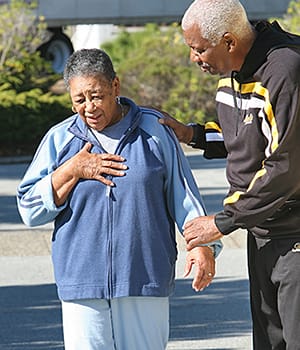You may be surprised to learn that heart disease is the biggest threat to your health—even more so than breast cancer. And the same factors that put you at risk of a heart attack, also known as acute myocardial infarction, or AMI, also increase your chances of stroke and other health problems. If your heart’s in trouble, your body may send you warning signs. It’s up to you to notice these and talk to your health care provider about them. Your health—and your life—could depend on it.
Learn to read the signs

When your heart isn’t getting enough oxygen, you may experience a feeling called angina. It can be a sign that you are at risk for having a heart attack. Angina is often referred to as “chest pain,” but this can be misleading. It’s not always painful, and it’s not always in the chest. Many women have other symptoms along with—or instead of—chest pain or discomfort. Talk to your health care provider if you notice any of the following:
- Discomfort, aching, tightness, or pressure that comes and goes. This may be in the back, abdomen, arm, shoulder, neck, or jaw. It can also be in the chest.
- Feeling much more tired than usual, for no clear reason.
- Becoming breathless while doing something that used to be easy.
- Heartburn, nausea, or a burning feeling that seems unrelated to food.
Get to the heart of the problem
Women often don’t realize their symptoms could be related to heart trouble. Even some health care providers don’t make the connection. If you feel any of the symptoms listed here, see your health care provider and ask to be tested for heart disease—even if you’re not sure that’s the cause. Tests, such as a stress echocardiogram and nuclear imaging, will reveal more about the problem. If your symptoms are heart-related, your health care provider will start treatment.
Hormone therapy Is not the answer
Health care providers used to think that older women could reduce their heart disease risk by taking hormones in pill form (hormone therapy, or HT). It turns out that’s not true. In fact, HT could actually increase your risk of having a heart attack or stroke. Talk to your health care provider about the risks and benefits of HT. It may be prescribed for other health problems. But it should not be taken to prevent or treat heart disease.
– See more at: http://krames.forthealthcare.com/Search/3,87051#sthash.siWFPEiw.dpuf
Understanding the risks and what you can control
Risk factors are habits and conditions that make heart disease more likely. The more you have, the higher your chances of heart attack, also known as acute myocardial infarction, or AMI, and other problems. Most risk factors can be managed to help make your heart healthier. Below are factors that increase your risk for having heart disease.

Smoking
This is the biggest of all the risk factors you can change. Smoking damages the lining of the blood vessels and raises blood pressure. Research shows that smoking makes women up to 6 times more likely to have a heart attack. Also avoid secondhand smoke (smoke from other people’s tobacco products).
Diabetes
Diabetes causes high blood sugar, which can damage blood vessels if not kept under control. Having diabetes also makes you more likely to have a silent heart attack—one without any symptoms. You’re at risk if your blood sugar level is above 100 mg/dL.
Unhealthy lipid levels
Lipids are fatty substances in the blood. LDL cholesterol and triglycerides (both bad lipids) can build up in artery walls, narrowing the arteries. HDL cholesterol (a good lipid) helps clear bad lipids away. You’re at risk if you have: HDL cholesterol 50 mg/dL or lower; LDL cholesterol 100 mg/dL or higher; triglycerides of 150 mg/dL or higher.
High blood pressure
High blood pressure occurs when blood pushes too hard against artery walls as it travels through the arteries. This damages the lining of the blood vessels making them narrow and stiff. You’re at risk if your blood pressure is 120/80 or higher.
Excess weight
Excess weight makes your heart work harder. This raises your risk of a heart attack. Being overweight also puts you at risk of developing diabetes. Excess weight around the waist or stomach increases your risk the most. Being obese puts you at risk for developing heart disease.
Lack of exercise
Without regular exercise, you’re more likely to develop other risk factors, such as being overweight and developing diabetes. High blood pressure and unhealthy lipid levels are also more likely.
Negative emotions
Emotions such as stress and pent-up anger have been linked to heart disease. Over time, these emotions could raise your heart disease risk. If you have heart disease, emotion such as anxiety and depression can make it worse.
Metabolic syndrome
This is caused by a combination of certain risk factors. It puts you at extra high risk of heart disease, stroke, and diabetes. You have metabolic syndrome if you have three or more of the following: low HDL cholesterol; high triglycerides; high blood pressure; high blood sugar; extra weight around the waist.
Risks you can’t control
A few risk factors can’t be changed. But they still raise your heart disease risk.
- Family history. If your mother or sister had heart trouble before age 65 or your father or brother before age 55, you’re at higher risk of having a heart attack.
- Age. The older you are, the higher your heart disease risk.
– See more at: http://krames.forthealthcare.com/Search/3,87055#sthash.5okR6oT1.dpuf
